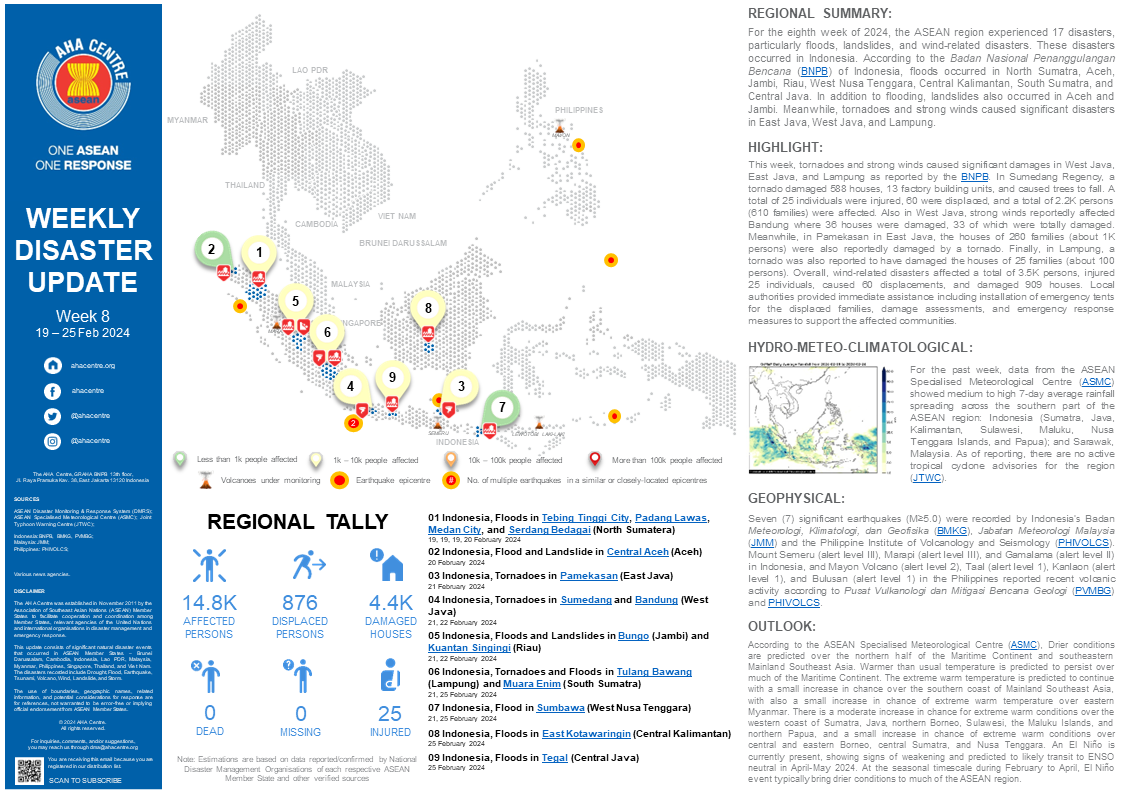
REGIONAL SUMMARY:
For the eighth week of 2024, the ASEAN region experienced 17 disasters, particularly floods, landslides, and wind-related disasters. These disasters occurred in Indonesia. According to the Badan Nasional Penanggulangan Bencana (BNPB) of Indonesia, floods occurred in North Sumatra, Aceh, Jambi, Riau, West Nusa Tenggara, Central Kalimantan, South Sumatra, and Central Java. In addition to flooding, landslides also occurred in Aceh and Jambi. Meanwhile, tornadoes and strong winds caused significant disasters in East Java, West Java, and Lampung.
.
HIGHLIGHT:
This week, tornadoes and strong winds caused significant damages in West Java, East Java, and Lampung as reported by the BNPB. In Sumedang Regency, a tornado damaged 588 houses, 13 factory building units, and caused trees to fall. A total of 25 individuals were injured, 60 were displaced, and a total of 2.2K persons (610 families) were affected. Also in West Java, strong winds reportedly affected Bandung where 36 houses were damaged, 33 of which were totally damaged. Meanwhile, in Pamekasan in East Java, the houses of 260 families (about 1K persons) were also reportedly damaged by a tornado. Finally, in Lampung, a tornado was also reported to have damaged the houses of 25 families (about 100 persons). Overall, wind-related disasters affected a total of 3.5K persons, injured 25 individuals, caused 60 displacements, and damaged 909 houses. Local authorities provided immediate assistance including installation of emergency tents for the displaced families, damage assessments, and emergency response measures to support the affected communities.
HYDRO-METEO-CLIMATOLOGICAL:
For the past week, data from the ASEAN Specialised Meteorological Centre (ASMC) showed medium to high 7-day average rainfall spreading across the southern part of the ASEAN region: Indonesia (Sumatra, Java, Kalimantan, Sulawesi, Maluku, Nusa Tenggara Islands, and Papua); and Sarawak, Malaysia. As of reporting, there are no active tropical cyclone advisories for the region (JTWC).
GEOPHYSICAL:
Seven (7) significant earthquakes (M>5.0) were recorded by Indonesia’s Badan Meteorologi, Klimatologi, dan Geofisika (BMKG), Jabatan Meteorologi Malaysia (JMM) and the Philippine Institute of Volcanology and Seismology (PHIVOLCS). Mount Semeru (alert level III), Marapi (alert level III), and Gamalama (alert level II) in Indonesia, and Mayon Volcano (alert level 2), Taal (alert level 1), Kanlaon (alert level 1), and Bulusan (alert level 1) in the Philippines reported recent volcanic activity according to Pusat Vulkanologi dan Mitigasi Bencana Geologi (PVMBG) and PHIVOLCS.
OUTLOOK:
According to the ASEAN Specialised Meteorological Centre (ASMC), Drier conditions are predicted over the northern half of the Maritime Continent and southeastern Mainland Southeast Asia. Warmer than usual temperature is predicted to persist over much of the Maritime Continent. The extreme warm temperature is predicted to continue with a small increase in chance over the southern coast of Mainland Southeast Asia, with also a small increase in chance of extreme warm temperature over eastern Myanmar. There is a moderate increase in chance for extreme warm conditions over the western coast of Sumatra, Java, northern Borneo, Sulawesi, the Maluku Islands, and northern Papua, and a small increase in chance of extreme warm conditions over central and eastern Borneo, central Sumatra, and Nusa Tenggara. An El Niño is currently present, showing signs of weakening and predicted to likely transit to ENSO neutral in April-May 2024. At the seasonal timescale during February to April, El Niño event typically bring drier conditions to much of the ASEAN region.
Sources:
ASEAN Disaster Monitoring & Response System (DMRS); ASEAN Specialised Meteorological Centre (ASMC); Joint Typhoon Warning Centre (JTWC);
Indonesia: BNPB, BMKG, PVMBG;
Malaysia: JMM;
Philippines: PHIVOLCS;
Various news agencies.







